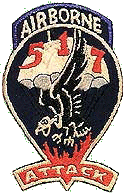INFANTRY REGIMENTAL COMBAT TEAM (SEPARATE)
IN THE VICINITY OF BERGSTEIN, GERMANY
4-8 FEBRUARY 1945. (RHINELAND CAMPAIGN)

By Capt. Roland L. Gohmert
ANALYSIS AMD CRITICISM
It is extremely difficult to unfavorably criticize the units involved in this operation, as the heroic actions of many small groups and individuals made it seem at the time that all possible was done in an attempt to accomplish the mission. However, in spite of the foregoing and the apparent futility of the mission, it must be realized that a great many sound tactical principles were violated.
The shortage of logistical and fire support of airborne units will not be discussed as these inadequacies have since been rectified by new and adequate T/O & E's.
In the planning stage, it should have been considered that this unit had been either in the attack or in movement almost constantly since the 18th of December, in the worst kind of weather and had suffered severe casualties. Committing parachute units to prolonged ground combat indicated a lack of knowledge on the part of higher planners as to their organisation. This was especially apparent in the fact that they were committed in the attack of heavily fortified positions. Had their limitations been realized and the necessary units attached to support the lightly armed rifle units, much greater success with far fewer casualties could have been attained.
Using the combat team on a diversionary mission from Bergstein, necessitated an attack with both flanks exposed. The enemy took full advantage of this situation with their fire from the south bank of the Kall. Had the attack been coordinated with another regiment on the right, with the boundary just to one side of the Kall or the other, it would have given one regiment a mine free corridor which would have left the prepared fortifications vulnerable to a night attack.
Another factor to the disadvantage of the combat team was attacking in the zone of one division while attached to, and supporting another. The 8th Division, although helpful in many respects, was not sympathetic to a situation which would attract fire and attention to their zone while they were in a defensive attitude. As the division boundaries were also corps boundaries, V Corps Artillery support of the combat team had to first be cleared through VII Corps. For the most part this precluded any effective support by corps artillery.
Neither time nor permission was available to the combat team for the extensive reconnaissance and patrolling which would have been necessary to insure at least some measure of success. Perhaps the shortage of time was unavoidable, but this could have been partially overcome had coordination been affected so as to have elements of the 8th Division in Bergstein accomplish some reconnaissance prior to the arrival of the combat team.
As to the conduct of the arttack itself, it is believed that the two battalions were prematurely withdrawn on the first attempt. This was probably due to the almost complete lack of knowledge of the enemy defenses, which in turn was caused by lack of reconnaissance. Again it must be emphasized that only two officers per company had seen any of the terrain in daylight. However, if both battalions could have passed through the minefield to the rear of the fortifications, surprise and confusion among the enemy would have been great enough to allow a reduction of his fortifications before an effective daylight counterattack could be organized and launched. This was partially proved by the complete freedom of the F Company commander in the vicinity of objective one.
In continued attacks later, all intermediate gains were lost due to the inability of the units to consolidate their positions so as to withstand the strong counterattacks. Due to the reduced strength of the attacking companies and the exposed flanks, a small perimeter defense might have repulsed the enemy. However, this could not be accomplished due to the terain and minefield restrictions. The enemy preparatory fires were very effective, but lifted long before the counterattacks. The counterattacks themselves were poorly executed, and were successful only through overrunning the companies positions with superior strength, and at the expense of heavy casualties.
The violation of radio security on the last day of the operation was the apparent cause of three needless casualties. However, had the battalion been up to strength and strung out to a correspondingly greater distance, the results could have been disastrous. Also it is reasonable to assume that the enemy deduced a change in units was taking place which undoubtedly was a basis for his future plans.

